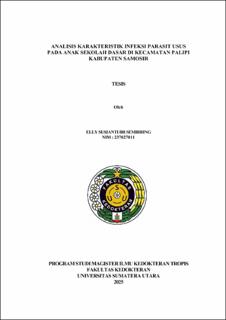Analisis Karakteristik Infeksi Parasit Usus pada Anak Sekolah Dasar di Kecamatan Palipi Kabupaten Samosir
Analysis of The Characteristics of Intestinal Parasitic Infections among Elementary School Children in Palipi District, Samosir Regency

Date
2025Author
Sembiring, Elly Susianti
Advisor(s)
Siahaan, Lambok
Lubis, Inke Nadia Diniyanti
Metadata
Show full item recordAbstract
Background. The prevalence of intestinal parasitic infections is still high in Indonesia and causes public health problems in Indonesia, especially in school-age children. This study was conducted to analyze the characteristics of intestinal parasitic infections in elementary school children in Palipi District, Samosir Regency.
Method. This study is a cross-sectional study conducted from January to March 2025 in five elementary schools in Pallipi District, Samosir Regency by taking the feces and blood of children from grade 1 to grade 6. Fecal examination was carried out at the Parasitology Laboratory, Faculty of Medicine, University of North Sumatra, using the katogas and formalin Ether methods. Data were analyzed using the chi-square test, Statistical Product, and Service Solutions version 27.
Result. Of the total 109 feces examined in the laboratory, there were 51 (46.8%) children who were positive for various types of intestinal parasites. The infection was mostly caused by Blastocystis sp, which infected 30 children (45.5%). Other infections were caused by Trichuris trichiura (24.2%), Entamoeba coly (15.2%), Giardia lamblia (12.1), Hymenolepis nana and Ascaris lumbricoides 1% each.
Conclusion. The prevalence of intestinal parasitic infections in elementary school children in Palipi district, Samosir Regency is 46.8%. The most common type of parasite is Blastocystis. There was a statistically significant relationship between soapy handwashing habits and diarrhea (p < 0.05) with intestinal parasitic infections. There was no significant association between intestinal parasite infection and anemia and nutritional status, but routine blood test results showed that the Hb levels of respondents infected with intestinal parasites were lower than those of uninfected respondents. The BMI value of respondents infected with intestinal parasites was lower compared to the BMI of respondents who were not infected with intestinal parasites.
Keywords. Intestinal parasitic infections, elementary school children, cross sectional
